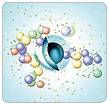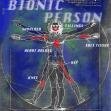
Chemistry is in the business of nanotechnology. Using principles of green chemistry, scientists are designing materials and processes that provide the maximum benefits of nanotechnology while minimizing potential hazards.
A Eurekalert press statement says that green nanochemistry is featured during a four-day symposium, "Nanotechnology and the Environment," at the 231st national meeting of the
American Chemical Society. The symposium also will address applications of nanotechnology in medicine, electronics, and energy.
EPA scientist addresses “state of the science” of environmental nanotechnology —Barbara Karn, Ph.D., an environmental scientist with the U.S. Environmental Protection Agency’s National Center for Environmental Research, provides an overview of the current “state of the science” of environmental nanotechnology, including greener processes and new applications of green nanotechnology.
“Twelve Principles of Green Chemistry” — Paul T. Anastas, Ph.D., director of the ACS Green Chemistry Institute, will discuss how to use the Twelve Principles of Green Chemistry to design the next generation of nanomaterials and the transformations necessary to make them. The principles, which include the prevention of waste and the design and use of safer chemicals, are key to achieving genuine sustainability for the simultaneous benefit of the environment, economy and society, he says.
Surface chemistry called key to designing non-toxic nanomaterials — Surface chemistry, not size and shape, appears to be the key feature governing the biological activity of nanoparticles, says Vicki Colvin, Ph.D., director of the Center for Biological and Environmental Nanotechnology at Rice University in Houston. This finding is being used to guide the development of greener nanomaterials that are less likely to pose health and environmental risks, she says.
New water-soluble carbon nanotubes could lead to improved electronics, medicine — Researchers at the New Jersey Institute of Technology say they have developed a simple, quick method - using microwave energy - for developing highly water-soluble carbon nanotubes. Because the new nanotubes are up to 125 times more water soluble than other carbon nanotubes, they also are more functional for a wider variety of potential applications, including thin films, composites, faster computer chips and improved drug delivery, according to study leader Somenath Mitra, Ph.D.
Nanomaterials shine spotlight on cheaper, more efficient solar cells — A. Paul Alivisatos, Ph.D., co-editor of the ACS journal Nano Letters and a chemist at the University of California, Berkeley, will discuss recent efforts to develop improved solar cells using nanomaterials, which could lead to greener, cheaper and more efficient ways to generate electricity.
Fuel cells may get efficiency boost with nanomaterials - Joseph M. DeSimone, Ph.D., a chemist at the University of North Carolina in Chapel Hill, is developing new proton exchange membranes patterned at the nanoscale that could lead to better, more efficient fuel cells. The development also may allow methanol to be used directly as a fuel source instead of hydrogen, he says.
Nanosphere sensors used to detect hazardous materials — Researchers at Oklahoma State University in Stillwater have developed polymer nanospheres that can be used to detect hazardous materials in aquatic environments near parts per billion levels. The sensors, which change their shape and optical properties depending on the chemical that is present, can be read by optical spectroscopic techniques to identify the chemical, the researchers say.
This is a facinating topic with so much to explore - for science junkies, that is.
 A press release this week says that a solar outburst, which can play havoc with global positioning systems and cell phone reception, bombarded Earth, Dec. 6, 2006, with a record amount of radio noise. Dale Gary, who just confirmed the news, is a professor and chair of the department of physics at New Jersey Institute of Technology.
A press release this week says that a solar outburst, which can play havoc with global positioning systems and cell phone reception, bombarded Earth, Dec. 6, 2006, with a record amount of radio noise. Dale Gary, who just confirmed the news, is a professor and chair of the department of physics at New Jersey Institute of Technology.






















 According to
According to  Sometimes I like to comment on good writing in public relations for science, and this press release from Salk Institute captures my interest. Plus, the topic is intriguing and will make you think about your impressions of the gait of just about everyone you know!
Sometimes I like to comment on good writing in public relations for science, and this press release from Salk Institute captures my interest. Plus, the topic is intriguing and will make you think about your impressions of the gait of just about everyone you know! Thanks goodness for the Snowe-Dorgan Bill, says Seana Mulcahy. It represents the "Internet Freedom Preservation Act of 2006.
Thanks goodness for the Snowe-Dorgan Bill, says Seana Mulcahy. It represents the "Internet Freedom Preservation Act of 2006.























